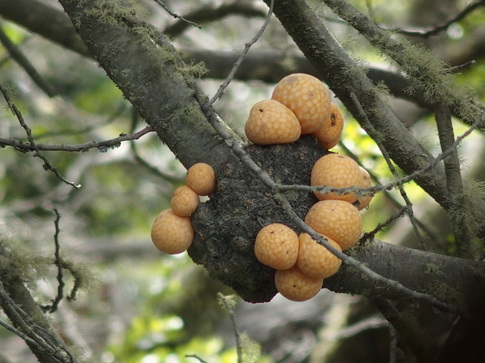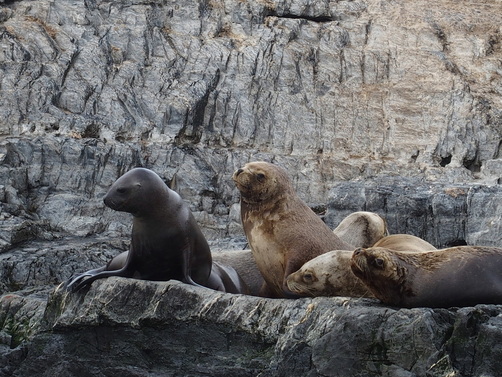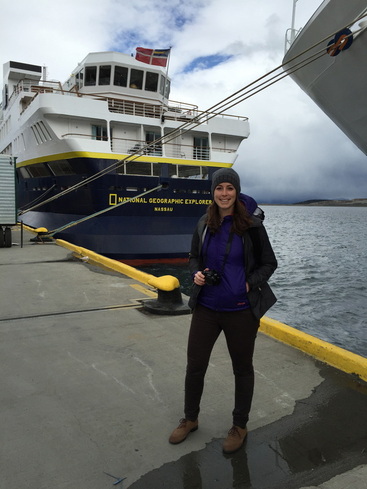TERRA FIRMA!!! Today started off with a buzz of excitement. During the night we had passed through the convergence, meaning that we were truly in Antarctic waters. Today would be the day when all of these people who have been waiting and planning for such a long time would finally touch their feet to Antarctica soil, or maybe I should say Antarctic Ice.
The change was evident not only by the excitement, but by the fact that we're now seeing icebergs on a regular basis as we sit and eat our meals or walk around the boat.
Before we could leave for shore we had to first listen to a mandatory debriefing about the protocols while on shore. These protocols have been establish by IAATO in order to help conserve Antarctica and make sure it remains relatively untouched. These protocols are quite similar to the Leave No Trace Principles but with some interesting differences. When I discuss LNT with my students we talk about the fact that it’s better to sit on a rock than it is on plant matter that can be damaged. However here in Antarctica you don’t want to step on plants (all two species of them) OR rocks because rocks are what house the lichens and are nesting sites for penguins. Speaking of penguins. Probably the most frequent question I heard before I left was “Can you bring me back a penguin”. I now have an answer for you. No. Unless you want to do my year of jail time and pay my $25,000 fine. We aren’t even allowed to approach them by any more than 15feet. There are actually people who troll facebook and other social media sites looking for evidence of people getting too close to Antarctic wildlife and they will prosecute you if they find you! That said, penguins can’t read and so if they choose to break the law, there’s nothing you can do about it.
In my ecotourism class we also talked about the importance of not bringing along any hitchhikers (seeds, eggs etc) along with us into other terrains. This is another aspect of the protocols, so after the debriefing we had to take any of our equipment that we would be using on land and have it vacuumed and decontaminated. I think I was the only one taking pictures of it, but it was nice to see something I teach my students put into practice on the other side of the world.
Then the moment we had all been waiting for arrived… penguins! Tons of them. We were cruising along through the English Straight when someone pointed out a group of them flying through the water. Everyone made mad dashes for cameras in order to put our newly learned camera skills to use. I didn’t get a great picture of this group but then another and another appeared. We saw upwards of a dozen groups of 10-20 penguins making their way to shore. I guess I had expected to see some penguins in the open water, but not this many! And then if that wasn’t enough the humpback whales decide to put on a show, breaching multiple times before showing us their tales as they dove down deeper to feed. According to the sonar on the boat there were krill balls below us, which is likely what was attracting them. As we were standing out on the bow, chatting about whales, I learned form Andy (Canadian naturalist, obviously he’s cool) that the Killer Whales in this area are genetically distinct from those found in BC waters. They believe that the last time they interbred was around 750,000 years ago!
At Half Moon Island the group had two options on shore. Go directly to the rookery (where penguins are nesting) or to do a 4mile hike around the island and then end up at the rookery. Bet you can’t guess which one I chose… After two days at sea and multiple days of travel I was definitely ready to stretch my legs and of course chose the hike. Perfect choice. We started by climbing to the top of the hill and getting a great view of the harbor as well as saw moss, lichen and the only grass in Antarctica. Botany goals for this trip have a officially been met! To avoid hiking all the way down we simple strapped our bags to our stomachs, rolled onto our backs and slid head first down the hill. Tobogganing goals for this trip have officially been met.
As we came around the far side of the island we ran into a couple of Weddell seals hanging out on the snow. While Weddell seals are great divers (they have much higher hemoglobin concentrations in the blood allowing them to carry a lot more oxygen) they have small jaws and therefore aren’t able to defend themselves in the same was as leopard or elephant seals. This is why we found a group of them sleeping on the snow where they are away from predators. When they leave this spot you can barely tell they were there because the blubber does such a good job of insulating them that they don’t even melt the snow beneath them. The seals were adorable and made very good photo subjects, doing all sorts of poses for us.
But it was the final stretch of the hike was truly the crowning glory of the hike. Up close and personal with a penguin rookery! Not only that but we got to hang out right next to the path where they return from the water… giving a 15foot birth of course! After all I’d been told and had read, I honestly thought it would smell worse. This was a relatively small rookery compared to some of the ones that the naturalists have described, so maybe it will be worse in the coming days. Or maybe it was just that I was so excited that I didn’t notice the smell. Or maybe it was that I’m from Chilliwack and I’m used to the smell. Regardless, I was hanging out with penguins! These were all chinstrap penguins, adorable little guys with a black chin strap and brown eyes (apparently all of the other have black eyes). We hung out here for as long as we were allowed and then rode in our zodiacs back to the boat.
After a quick clean up it was time for the Captain’s Reception and recap from the day. It was interrupted by some squeals and pointing and we once again had whales off of our port side. Lots of them! It was also announced that we’d have a bonus stop this evening after dinner at Deception Island. The bay itself is actually the caldera of an ACTIVE volcano! The side of it had collapsed filling the caldera with water and creating a crescent shape bay, basically imagine a croissant shaped island. It formerly housed a whaling station and now is an occasional research station, and apparently up until 3 years ago had a hot spot that would warm the waters around the inner edge of the caldera. They used to dig pits in the sand and allow them to fill with water and create hot tubs, but it’s no longer allowed as it doesn’t really fit with the whole leave no trace thing! One shore we could see the remnants of the old whaling station, including some row boats, tanks to hold the rendered oil and outbuildings. Eric (naturalist) told us a story about a girl who had tried to hide out on this island during an earlier expedition so that she could attempt to live there for a year. She basically spent the day sneaking supplies from the boat and then hiding so that the ship would leave without her. Fortunately someone noticed and they went back to get her, but even as they were driving the zodiac towards the ship she jumped overboard trying to get back. Not surprisingly she was on watch the rest of the way back to Ushuaia. I think he said this happened ~15 years ago, but still crazy to believe that anyone could think they could survive an Antarctic winter with a couple of supplies stolen from a boat.
Well I best be wrapping up it's midnight and twilight but I need to get some sleep. Couple of more landings tomorrow and possibly some kayaking.
Hope you’re all having a great start to your Christmas holidays!
Well I best be wrapping up it's midnight and twilight but I need to get some sleep. Couple of more landings tomorrow and possibly some kayaking.
Hope you’re all having a great start to your Christmas holidays!













 RSS Feed
RSS Feed
